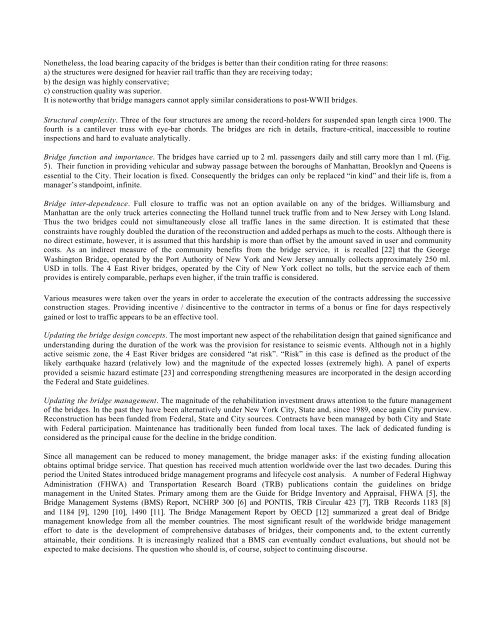MANAGING THE EAST RIVER BRIDGES IN NEW YORK CITY
MANAGING THE EAST RIVER BRIDGES IN NEW YORK CITY
MANAGING THE EAST RIVER BRIDGES IN NEW YORK CITY
You also want an ePaper? Increase the reach of your titles
YUMPU automatically turns print PDFs into web optimized ePapers that Google loves.
Nonetheless, the load bearing capacity of the bridges is better than their condition rating for three reasons:<br />
a) the structures were designed for heavier rail traffic than they are receiving today;<br />
b) the design was highly conservative;<br />
c) construction quality was superior.<br />
It is noteworthy that bridge managers cannot apply similar considerations to post-WWII bridges.<br />
Structural complexity. Three of the four structures are among the record-holders for suspended span length circa 1900. The<br />
fourth is a cantilever truss with eye-bar chords. The bridges are rich in details, fracture-critical, inaccessible to routine<br />
inspections and hard to evaluate analytically.<br />
Bridge function and importance. The bridges have carried up to 2 ml. passengers daily and still carry more than 1 ml. (Fig.<br />
5). Their function in providing vehicular and subway passage between the boroughs of Manhattan, Brooklyn and Queens is<br />
essential to the City. Their location is fixed. Consequently the bridges can only be replaced “in kind” and their life is, from a<br />
manager’s standpoint, infinite.<br />
Bridge inter-dependence. Full closure to traffic was not an option available on any of the bridges. Williamsburg and<br />
Manhattan are the only truck arteries connecting the Holland tunnel truck traffic from and to New Jersey with Long Island.<br />
Thus the two bridges could not simultaneously close all traffic lanes in the same direction. It is estimated that these<br />
constraints have roughly doubled the duration of the reconstruction and added perhaps as much to the costs. Although there is<br />
no direct estimate, however, it is assumed that this hardship is more than offset by the amount saved in user and community<br />
costs. As an indirect measure of the community benefits from the bridge service, it is recalled [22] that the George<br />
Washington Bridge, operated by the Port Authority of New York and New Jersey annually collects approximately 250 ml.<br />
USD in tolls. The 4 East River bridges, operated by the City of New York collect no tolls, but the service each of them<br />
provides is entirely comparable, perhaps even higher, if the train traffic is considered.<br />
Various measures were taken over the years in order to accelerate the execution of the contracts addressing the successive<br />
construction stages. Providing incentive / disincentive to the contractor in terms of a bonus or fine for days respectively<br />
gained or lost to traffic appears to be an effective tool.<br />
Updating the bridge design concepts. The most important new aspect of the rehabilitation design that gained significance and<br />
understanding during the duration of the work was the provision for resistance to seismic events. Although not in a highly<br />
active seismic zone, the 4 East River bridges are considered “at risk”. “Risk” in this case is defined as the product of the<br />
likely earthquake hazard (relatively low) and the magnitude of the expected losses (extremely high). A panel of experts<br />
provided a seismic hazard estimate [23] and corresponding strengthening measures are incorporated in the design according<br />
the Federal and State guidelines.<br />
Updating the bridge management. The magnitude of the rehabilitation investment draws attention to the future management<br />
of the bridges. In the past they have been alternatively under New York City, State and, since 1989, once again City purview.<br />
Reconstruction has been funded from Federal, State and City sources. Contracts have been managed by both City and State<br />
with Federal participation. Maintenance has traditionally been funded from local taxes. The lack of dedicated funding is<br />
considered as the principal cause for the decline in the bridge condition.<br />
Since all management can be reduced to money management, the bridge manager asks: if the existing funding allocation<br />
obtains optimal bridge service. That question has received much attention worldwide over the last two decades. During this<br />
period the United States introduced bridge management programs and lifecycle cost analysis. A number of Federal Highway<br />
Administration (FHWA) and Transportation Research Board (TRB) publications contain the guidelines on bridge<br />
management in the United States. Primary among them are the Guide for Bridge Inventory and Appraisal, FHWA [5], the<br />
Bridge Management Systems (BMS) Report, NCHRP 300 [6] and PONTIS, TRB Circular 423 [7], TRB Records 1183 [8]<br />
and 1184 [9], 1290 [10], 1490 [11]. The Bridge Management Report by OECD [12] summarized a great deal of Bridge<br />
management knowledge from all the member countries. The most significant result of the worldwide bridge management<br />
effort to date is the development of comprehensive databases of bridges, their components and, to the extent currently<br />
attainable, their conditions. It is increasingly realized that a BMS can eventually conduct evaluations, but should not be<br />
expected to make decisions. The question who should is, of course, subject to continuing discourse.
















